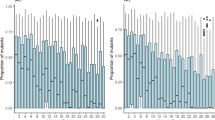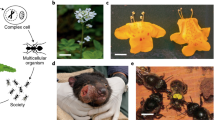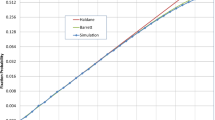Abstract
Deleterious mutations are typically understood exclusively in terms of their harmful effects on carrier organisms. But there are convincing reasons to think that such adverse effects are not confined to the individual level. We argue that in social species, interorganismal gene-gene interactions, which in previous literatures have been termed social epistasis, allow genomes carrying deleterious mutations to reduce via group-level pleiotropy the fitness of others, including noncarriers. This fitness reduction occurs by way of degradation of group-level processes that optimize the reproductive ecology of a population for intergroup competition through, among other mechanisms, suppression of free-riding. Such damage to group regulatory processes suggests a hidden role for the accumulation of behavior-altering "spiteful" mutations in the dynamics of the demographic transition—these mutations may have contributed to the maladaptive outcomes of this process, such as widespread subreplacement fertility. A structured population model is presented describing aspects of this social epistasis amplification model. This phenomenon is also considered as a potential explanation for the results of Calhoun’s mouse utopia experiments, which provide an opportunity to directly test a major prediction stemming from the model.



Similar content being viewed by others
Notes
Mutation accumulation research involving the nematode Caenorhabditis elegans indicates that, even when there are no reductions in viability (Keightley and Caballero 1997), behavioral changes, such as degraded chemotaxis and locomotion, can nevertheless be observed (Ajie et al. 2005). On this basis, Lynch (2016) has speculated that in human populations, behavioral degradation via mutation accumulation may be occurring at a faster rate than intrinsic fitness loss.
References
Ajie, B. C., Estes, S., Lynch, M., & Phillips, P. C. (2005). Behavioral degradation under mutation accumulation. Genetics, 170, 655–660.
Arslan, R.C., Willführ, K.P., Frans, E., Verweij, K.J.H., Myrskylä, M., Voland, E., … Penke, L. (2016). Older fathers’ children have lower evolutionary fitness across four centuries and in four populations. BioRxiv, 042788.
Barry, T. D., Grafeman, S. J., Bader, S. H., & Davis, S. E. (2011). Narcissism, positive illusory bias, and externalizing behaviors. In C. T. Barry, P. K. Kerig, K. K. Stellwagen, & T. D. Barry (Eds.), Narcissism and Machiavellianism in youth: implications for the development of adaptive and maladaptive behavior (pp. 159–173). Washington: American Psychological Association.
Basten, S., Lutz, W. & Scherbov, S. (2013). Very long range global population scenarios to 2300 and the implications of sustained low fertility. Demographic Research, 28, 1145–1166.
Benatar, D. (2006). Better never to have been: the harm of coming into existence. Oxford: Clarendon Press.
Blaxill, M. F. (2004). What’s going on? The question of time trends in autism. Public Health Reports, 119, 536–551.
Bryant, E. H., & Reed, D. H. (1999). Fitness decline under relaxed selection in captive populations. Conservation Biology, 13, 665–669.
Budnik, A., & Henneberg, M. (2017). Worldwide increase of obesity is related to the reduced opportunity for natural selection. PLOS ONE, 12, e0170098.
Caldwell, J. C., Caldwell, B. K., Caldwell, P., McDonald, P. F., & Schindlmayr, T. (2006). Demographic transition theory. Dordrecht: Springer.
Calhoun, J. B. (1973). Death squared: the explosive growth and demise of a mouse population. Proceedings of the National Academy of Sciences USA, 66, 80–88.
Center for Disease Control. (2010). Increasing prevalence of parent-reported attention deficit/hyperactivity disorder among children—United States, 2003 and 2007. Morbidity & Mortality Weekly Report, 59, 1439–1443.
Charlton, B. G. (2009). Clever sillies: why high IQ people tend to be deficient in common sense. Medical Hypotheses, 73, 867–870.
Chiao, J. Y., & Blizinsky, K. D. (2010). Culture-gene coevolution of individualism-collectivism and the serotonin transporter gene. Proceedings: Biological Sciences, 277, 529–537.
Clark, G. (2007). A farewell to alms: a brief economic history of the world. Princeton: Princeton University Press.
Cushing, J.M. (1998). An introduction to structured population models. Conference Series in Applied Mathematics, 7 1, SIAM, Philadelphia.
D’Onofrio, B. M., Rickert, M. E., Frans, E., Kuja-Halkola, R., Almqvist, C., Sjölander, A., & Lichtenstein, P. (2014). Paternal age at childbearing and offspring psychiatric and academic morbidity. JAMA Psychiatry, 71, 432.
Dawkins, R. (1982). The extended phenotype: the gene as the unit of selection. Oxford: Oxford University Press.
Dutton, E., & van der Linden, D. (2015). Who are the “Clever Sillies”? The intelligence, personality, and motives of clever silly originators and those who follow them. Intelligence, 49, 57–65.
Eckersley, R. (2012). Whatever happened to Western civilization? The cultural crisis, 20 years later. The Futurist, 46, 16–22.
Fieder, M., & Huber, S. (2015). Paternal age predicts offspring chances of marriage and reproduction. American Journal of Human Biology, 27, 339–343.
Gayle, D. (2016). Drug-related deaths hit record levels in England and Wales. The Guardian. Retrieved November 22, 2016, from https://www.theguardian.com/society/2016/sep/09/drug-related-deaths-hit-record-levels-england-wales.
Goldstone, J. A., Kaufmann, E., & Toft, M. D. (2011). Political demography: how population changes are reshaping international security and national politics. Boulder: Paradigm.
Hawrylycz, M. J., Lein, E. S., Guillozet-Bongaarts, A. L., Shen, E. H., Ng, L., Miller, J. A., & Jones, A. R. (2012). An anatomically comprehensive atlas of the adult human brain transcriptome. Nature, 489, 391–399.
Heiderstadt, K. M., Vandenbergh, D. J., Gyekis, J. P., & Blizard, D. A. (2014). Communal nesting increases pup growth but has limited effects on adult behavior and neurophysiology in inbred mice. Journal of the American Association for Laboratory Animal Science, 53, 152–160.
Houle, D. (2000). Is there a g factor for fitness? In G. R. Bock, J. A. Goode, & K. Webb (Eds.), The nature of intelligence (pp. 149–170). Chichester: Wiley.
Huber, S., & Fieder, M. (2014). Advanced paternal age is associated with lower facial attractiveness. Evolution & Human Behavior, 35, 298–301.
Inglehart, R. F. (1977). The silent revolution: changing values and political styles among Western publics. Princeton: Princeton University Press.
Inglehart, R., & Appel, D. (1989). The rise of postmaterialist values and changing religious orientations, gender roles and sexual norms. International Journal of Public Opinion Research, 1, 45–75.
Inglehart, R. F., & Welzel, C. (2005). Modernization, cultural change, and democracy: the human development sequence. Cambridge: Cambridge University Press.
Ingraham, C. (2015). Americans are drinking themselves to death at record rates. Washington Post. Retrieved November 29, 2016, from https://www.washingtonpost.com/news/wonk/wp/2015/12/22/americans-are-drinking-themselves-to-death-at-record-rates/.
Jones, D. N., & Figueredo, A. J. (2012). The core of darkness: uncovering the heart of the dark triad. European Journal of Personality, 27, 521–531.
Kanazawa, S. (2005). An empirical test of a possible solution to “the central theoretical problem of human sociobiology”. Journal of Cultural & Evolutionary Psychology, 3, 255–266.
Keightley, P. D., & Caballero, A. (1997). Genomic mutation rates for lifetime reproductive output and lifespan in Caenorhabditis elegans. Proceedings of the National Academy of Sciences USA, 94, 3823–3827.
Kimmerle, E. H., & Jantz, R. L. (2006). Secular trends in craniofacial asymmetry studied by geometric morphometry and generalized procrustes methods. In D. E. Slice (Ed.), Modern morphometrics in physical anthropology (pp. 247–263). New York: Springer.
Klein, T. (1990). Postmaterialismus und generatives Verhalten. Zeitschrift Für Soziologie, 19, 57–64.
Kondrashov, A. S., & Crow, J. F. (1993). A molecular approach to estimating the human deleterious mutation rate. Human Mutation, 2, 229–234.
Kong, A., Frigge, M. L., Masson, G., Besenbacher, S., Sulem, P., Magnusson, G., & Stefansson, K. (2012). Rate of de novo mutations and the importance of father’s age to disease risk. Nature, 488, 471–475.
Lasch, C. (1979). The culture of narcissism: American life in an age of diminishing expectations. New York: Norton.
Laursen, T. M., Munk-Olsen, T., Nordentoft, M., & Mortensen, P. B. (2007). A comparison of selected risk factors for unipolar depressive disorder, bipolar affective disorder, schizoaffective disorder, and schizophrenia from a Danish population-based cohort. Journal of Clinical Psychiatry, 68, 1673–1681.
Lesecque, Y., Keightley, P. D., & Eyre-Walker, A. (2012). A resolution of the mutation load paradox in humans. Genetics, 191, 1321–1330.
Linksvayer, T. A. (2007). Ant species differences determined by epistasis between brood and worker genomes. PloS One, 2, e994.
Lynch, M. (2016). Mutation and human exceptionalism: our future genetic load. Genetics, 202, 869–875.
Lynch, M., Sung, W., Morris, K., Coffey, N., Landry, C. R., Dopman, E. B., & Thomas, W. K. (2008). A genome-wide view of the spectrum of spontaneous mutations in yeast. Proceedings of the National Academy of Sciences, 105, 9272–9277.
MacDonald, K. B. (1994). A people that shall dwell alone: Judaism as a group evolutionary strategy. Westport: Praeger.
MacDonald, K. B. (2008). Effortful control, explicit processing and the regulation of human evolved predispositions. Psychological Review, 115, 1012–1031.
MacDonald, K. B. (2009). Evolution, psychology, and a conflict theory of culture. Evolutionary Psychology, 7, 208–233.
MacDonald, K.B. (2010). Evolution and a dual processing theory of culture: applications to moral idealism and political philosophy. Politics & Culture, 1.
Mace, R. (2000). Evolutionary ecology of human life history. Animal Behavior, 59, 1–10.
McManus, I. C., Moore, J., Freegard, M., & Rawles, R. (2010). Science in the making: right hand, left hand. III: Estimating historical rates of left-handedness. Laterality, 15, 186–208.
Meikle, J. (2016). Alcohol-related deaths in England up 4% in one year. The Guardian. Retrieved November 20, 2016, from https://www.theguardian.com/society/2016/jun/30/alcohol-related-deaths-up-4-per-cent-one-year.
Meisenberg, G. (2011). Secularization and desecularization in our time. The Journal of Social, Political & Economic Studies, 36, 318–359.
Miller, G. F. (2000). Mental traits as fitness indicators: expanding evolutionary psychology’s adaptationism. Annals of the New York Academy of Sciences, 907, 62–74.
Miller, G. (2007). Sexual selection for moral virtues. The Quarterly Review of Biology, 82, 97–125.
Mukai, T. (1964). The genetic structure of natural populations of Drosophila melanogaster. 1. Spontaneous mutation rate of polygenes controlling viability. Genetics, 50, 1–19.
Muller, H. J. (1950). Our load of mutations. American Journal of Human Genetics, 2, 111–176.
Oakley, B. A. (2013). Concepts and implications of altruism bias and pathological altruism. Proceedings of the National Academy of Sciences, USA, 110, 10408–10415.
Oakley, B., Knafo, A., Madhavan, G., & Wilson, D. S. (Eds.). (2012). Pathological altruism. Oxford: Oxford University Press.
Perkins, A. M. (2016). The welfare trait: how state benefits affect personality. New York: Palgrave Macmillan.
Perkins, A. M., Cserjesi, R., Ettinger, U., Kumari, V., Martin, N. G., & Arden, R. (2013). Personality and occupational markers of ‘solid citizenship’ are associated with having fewer children. Personality & Individual Differences, 55, 871–876.
Pflüger, L. S., Oberzaucher, E., Katina, S., Holzleitner, I. J., & Grammer, K. (2012). Cues to fertility: perceived attractiveness and facial shape predict reproductive success. Evolution & Human Behavior, 33, 708–714.
Pinker, S. (2011). The better angels of our nature: why violence has declined. New York: Viking.
Potter, M. (Ed.). (1985). The BALB/c mouse: genetics and immunology. Berlin: Springer.
Rahbari, R., Wuster, A., Lindsay, S. J., & Hurles, M. E. (2016). Timing, rates and spectra of human germline mutation. Nature Genetics, 48, 126–133.
Richerson, P. J., & Boyd, R. (2005). Not by genes alone: how culture transformed human evolution. Chicago: University of Chicago Press.
Rubin, E. L. (2015). Soul, self, and society: the new morality and the modern state. New York: Oxford University Press.
Rudd, R. A., Aleshire, N., Zibbell, J. E., & Gladden, R. M. (2016). Increases in drug and opioid overdose deaths—United States, 2000–2014. Morbidity & Mortality Weekly Report, 64, 1378–1382.
Rühli, F. J., & Henneberg, M. (2013). New perspectives on evolutionary medicine: the relevance of microevolution for human health and disease. BMC Medicine, 11, 115.
Rushton, J.P., & Irwing, P. (2011). The general factor of personality: normal and abnormal. In: T. Chamorro-Premuzic, S.v. Stumm & A. Furnham (Eds.), The Wiley-Blackwell handbook of individual differences (pp. 132–161). Oxford: Blackwell.
Saha, S., Barnett, A. G., Buka, S. L., & McGrath, J. J. (2009). Maternal age and paternal age are associated with distinct childhood behavioural outcomes in a general population birth cohort. Schizophrenia Research, 115, 130–135.
Sandler, L. (2013). Having it all without having children. Time Magazine. Retrieved January 15, 2017, from http://time.com/241/having-it-all-without-having-children/
Shabalina, S. A., Yampolsky, L. Y., & Kondrashov, A. S. (1997). Rapid decline of fitness in panmictic populations of Drosophila melanogaster maintained under relaxed natural selection. Proceedings of the National Academy of Sciences, USA, 94, 13034–13039.
Silverman, J. L., Yang, M., Lord, C., & Crawley, J. N. (2010). Behavioural phenotyping assays for mouse models of autism. Nature Reviews. Neuroscience, 11, 490–502.
Sinervo, B., Clobert, J., Miles, D. B., McAdam, A., & Lancaster, L. T. (2008). The role of pleiotropy vs signaler-receiver gene epistasis in life history trade-offs: dissecting the genomic architecture of organismal design in social systems. Heredity, 101, 197–211.
Spain, S. L., Pedroso, I., Kadeva, N., Miller, M. B., Iacono, W. G., Mcgue, M., & M.A., S. (2015). A genome-wide analysis of putative functional and exonic variation associated with extremely high intelligence. Molecular Psychiatry, 21, 1145–1151.
Spurk, D., Keller, A. C., & Hirschi, A. (2015). Do bad guys get ahead or fall behind? Relationships of the dark triad of personality with objective and subjective career success. Social Psychological & Personality Science, 7, 113–121.
Twenge, J. M., & Campbell, W. K. (2009). The narcissism epidemic: living in the age of entitlement. New York: Free Press.
Twenge, J. M., Zhang, L., & Im, C. (2004). It’s beyond my control: a cross-temporal meta-analysis of increasing externality in locus of control, 1960–2002. Personality & Social Psychology Review, 8, 308–319.
Twenge, J. M., Gentile, B., Dewall, C. N., Ma, D., Lacefield, K., & Schurtz, D. R. (2010). Birth cohort increases in psychopathology among young Americans, 1938–2007: a crosstemporal meta-analysis of the MMPI. Clinical Psychology Review, 30, 145–154.
Volk, T., & Atkinson, J. (2013). Infant and child death in the human environment of evolutionary adaptation. Evolution & Human Behavior, 34, 182–192.
Wattenberg, B. J. (1985). The good news is the bad news is wrong. Washington: American Enterprise Institute.
Way, B. M., & Lieberman, M. D. (2010). Is there a genetic contribution to cultural differences? Collectivism, individualism and genetic markers of social sensitivity. Social Cognitive & Affective Neuroscience, 5, 203–211.
Welzel, C. (2013). Freedom rising: human empowerment and the quest for emancipation. New York: Cambridge University Press.
Wilson, D. S. (2002). Darwin’s cathedral: evolution, religion, and the nature of society. Chicago: University of Chicago Press.
Wong, W. S., Solomon, B. D., Bodian, D. L., Kothiyal, P., Eley, G., Huddleston, K. C., & Niederhuber, J. E. (2016). New observations on maternal age effect on germline de novo mutations. Nature Communications, 7, 10486.
Woodley, M. A. (2010). Are high-IQ individuals deficient in common sense? A critical examination of the ‘clever sillies’ hypothesis. Intelligence, 38, 471–480.
Woodley of Menie, M. A., & Kanazawa, S. (2017). Paternal age negatively predicts offspring attractiveness in two, large, nationally representative datasets. Personality & Individual Differences, 106, 217–221.
Woodley of Menie, M. A., Reeve, C. L., Kanazawa, S., Meisenberg, G., Fernandes, H. B. F., & Cabeza de Baca, T. (2016a). Contemporary phenotypic selection on intelligence is (mostly) directional: an analysis of three, population representative samples. Intelligence, 59, 109–114.
Woodley of Menie, M. A., & Fernandes, H. B. F. (2016). The secular decline in general intelligence from decreasing developmental stability: theoretical and empirical considerations. Personality & Individual Differences, 92, 194–199.
Woodley of Menie, M.A., Cabeza de Baca, T., Fernandes, H.B.F., Madison, G., & Figueredo, A.J. (2016b). Slow and steady wins the race: K positively predicts fertility in the USA and Sweden. Evolutionary Psychological Science. in press. doi:10.1007/s40806-016-0077-1.
Woodley, M. A., & Figueredo, A. J. (2013). Historical variability in heritable general intelligence: its evolutionary origins and socio-cultural consequences. Buckingham: Buckingham University Press.
Woods, R. (2008). Long-term trends in fetal mortality: implications for developing countries. Bulletin of the World Health Organization, 86, 460–466.
Acknowledgements
We are grateful to two anonymous reviewers for comments that substantially improved this manuscript. We are especially grateful also to Prof. AJ Figueredo and Dr. Bruce Charlton for detailed discussion of and commentary on several of the ideas put forward in the present work.
Author information
Authors and Affiliations
Corresponding author
Rights and permissions
About this article
Cite this article
Woodley of Menie, M.A., Sarraf, M.A., Pestow, R.N. et al. Social Epistasis Amplifies the Fitness Costs of Deleterious Mutations, Engendering Rapid Fitness Decline Among Modernized Populations. Evolutionary Psychological Science 3, 181–191 (2017). https://doi.org/10.1007/s40806-017-0084-x
Published:
Issue Date:
DOI: https://doi.org/10.1007/s40806-017-0084-x




